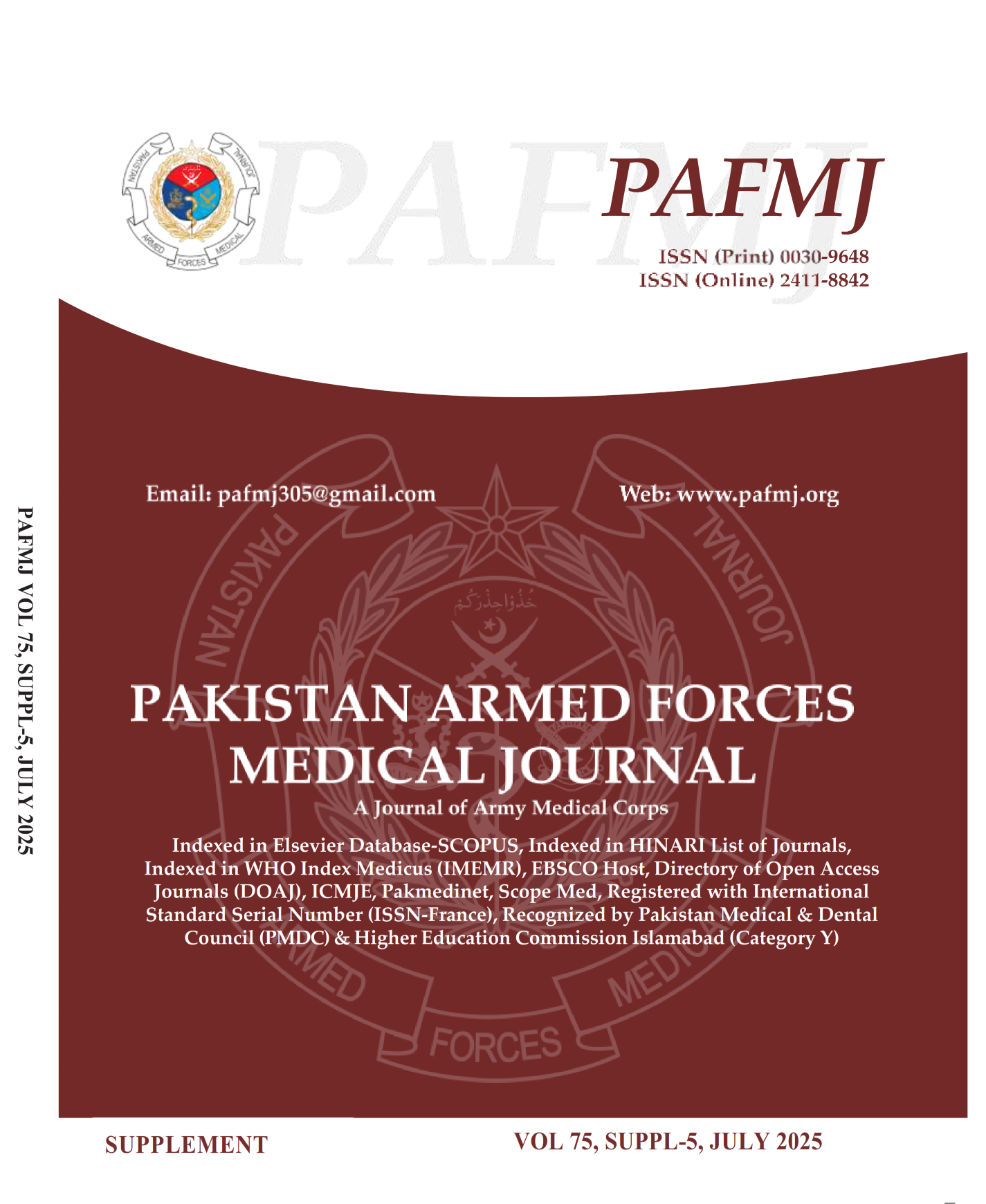Time Is Brain; Factors Influencing The Outcome of Missile Head Injuries In Conflict Zone
DOI:
https://doi.org/10.51253/pafmj.v75iSUPPL-5.8062Keywords:
optimization, penetrating head injuries, conflict zoneAbstract
Objective: To analyze factors influencing the outcome in patients with missile head injuries sustained in the conflict zone, to help in developing a plan for treating and optimizing such patients.
Study Design: Retrospective longitudinal study
Place and Duration of Study: Neurosurgical unit Combined Military Hospital Peshawar, Pakistan from Jul 2015 to Jun 2018.
Methodology: Over a period of three years 66 male patients met the criteria with a mean age of 28 yrs. The variables identified were mechanism of injury: blast or gunshot injury, glasgow coma score (GCS) on arrival, time to reach to neurosurgical facility, location of entry wound, presence of Polytrauma, Pupils status, CT scan findings, surgical treatment, retained foreign body, seizures, hydrocephalus, cerebrospinal fluid leak and glasgow outcome scale extended (GOS E) score of 1-8.
Results: Out of 66 patients, 12 patients (18.2%) sustained bullet injuries and 54 (81.8%) sustained blast splinter injuries to head. There were 24 patients (36.4%) with GOS score of 1 (death), 4 patients (6.1%) with GOS score of 6 (moderate disability), 9 patients (13.6%) with GOS score of 7 (good recovery lower) and 29 patients (43.9%) with GOS score 8 (good recovery).
Conclusion: In time adequate triage and prompt optimisation of patients before and during the safe medical evacuation of penetrating head injuries in the austere environment of conflict zone will lead the efforts to save the survivables and will push the balance to many good outcomes
Downloads
References
1. Cushing H. A study of a series of wounds involving the brain and its enveloping structures. Br J Surg [Internet]. 2006; 5(20): 558–684.
2. Agarwalla PK, Dunn GP, Laws ER. An historical context of modern principles in the management of intracranial injury from projectiles. Neurosurg Focus. 2010; 28(5): E23.
3. Bell RS, Mossop CM, Dirks MS, Stephens FL, Mulligan L, Ecker R, et al. Early decompressive craniectomy for severe penetrating and closed head injury during wartime. Neurosurg Focus. 2010; 28(5): E1.
4. Bell RS, Vo AH, Neal CJ, Tigno J, Roberts R, Mossop C, Dunne JR, Armonda RA. Military traumatic brain and spinal column injury: a 5-year study of the impact blast and other military grade weaponry on the central nervous system. J Trauma. 2009; 66(4 Suppl): S104-11.
5. Rosenfeld JV, Bell RS, Armonda R. Current concepts in penetrating and blast injury to the central nervous system. World J Surg. 2015; 39(6): 1352–62.
6. Ragel BT, Klimo P Jr, Martin JE, Teff RJ, Bakken HE, Armonda RA. Wartime decompressive craniectomy: technique and lessons learned. Neurosurg Focus. 2010; 28(5): E2.
7. Aarabi B, Tofighi B, Kufera JA, Hadley J, Ahn ES, Cooper C, et al. Predictors of outcome in civilian gunshot wounds to the head: Clinical article. J Neurosurg. 2014; 120(5): 1138–46.
8. Smith JE, Kehoe A, Harrisson SE, Russell R, Midwinter M. Outcome of penetrating intracranial injuries in a military setting. Injury. 2014; 45(5): 874–8.
9. Sakr S, Azzazi A, Elsayed A, Fathalla H. Surgical management of penetrating intracranial bullet injuries. Neurosurg Q. 2016; 26(1): 37–41.
10. Fathalla H, Ashry A, El-Fiki A. Managing military penetrating brain injuries in the war zone: lessons learned. Neurosurg Focus. 2018; 45(6): E6.
11. Gönül E, Erdoğan E, Taşar M, Yetişer S, Akay KM, Düz B, et al. Penetrating orbitocranial gunshot injuries. Surg Neurol. 2005; 63(1): 24–30; discussion 31.
12. Dagain A, Aoun O, Bordes J, Roqueplo C, Joubert C, Esnault P, et al. Management of war-related ballistic craniocerebral injuries in a French role 3 hospital during the Afghan campaign. World Neurosurg. 2017; 102: 6–12.
13. Hofbauer, M., Kdolsky, R., Figl, M., Grünauer, J., Aldrian, S., Ostermann, R.C. and Vècsei, V. (2010). Predictive factors influencing the outcome after gunshot injuries to the head-a retrospective cohort study. The Journal of Trauma, 69(4), pp.770–775.
14. Martins RS, Siqueira MG, Santos MTS, Zanon-Collange N, Moraes OJS. Prognostic factors and treatment of penetrating gunshot wounds to the head. Surg Neurol. 2003; 60(2): 98–104; discussion 104.
15. Can Ç, Bolatkale M, Sarıhan A, Savran Y, Acara AÇ, Bulut M. The effect of brain tomography findings on mortality in sniper shot head injuries. J R Army Med Corps. 2017; 163(3): 211–4.
16. Bahadur S, McGilloway E, Etherington J. Injury severity at presentation is not associated with long-term vocational outcome in British Military brain injury. J R Army Med Corps. 2016; 162(2): 120–4.
17. Bakir A, Temiz C, Umur S, Aydin V, Torun F. High-velocity gunshot wounds to the head: analysis of 135 patients. Neurol Med Chir (Tokyo). 2005; 45(6): 281–7; discussion 287.
18. Splavski B, Vranković D, Sarić G, Saftić R, Maksimović Z, Bajek G, et al. Early surgery and other indicators influencing the outcome of war missile skull base injuries. Surg Neurol. 1998; 50(3): 194–9.
19. Kazim SF, Shamim MS, Tahir MZ, Enam SA, Waheed S. Management of penetrating brain injury. J Emerg Trauma Shock. 2011; 4(3): 395–402.
20. Khan Z, Ali M, Sharafat S, Usman M, Aman R, Khan KM, et al. Bomb Blast Head Injuries: A Two Years Experience of 154 Patients. Rawal Medical Journal. 2012; 37(4): 417–20.
21. Goldstein LE, Fisher AM, Tagge CA, Zhang X-L, Velisek L, Sullivan JA, et al. Chronic traumatic encephalopathy in blast-exposed military veterans and a blast neurotrauma mouse model. Sci Transl Med. 2012; 4(134): 134ra60.
Downloads
Published
Issue
Section
License
Copyright (c) 2025 Zahid Hussain, Shahzad Ahmed qasmi

This work is licensed under a Creative Commons Attribution-NonCommercial 4.0 International License.















